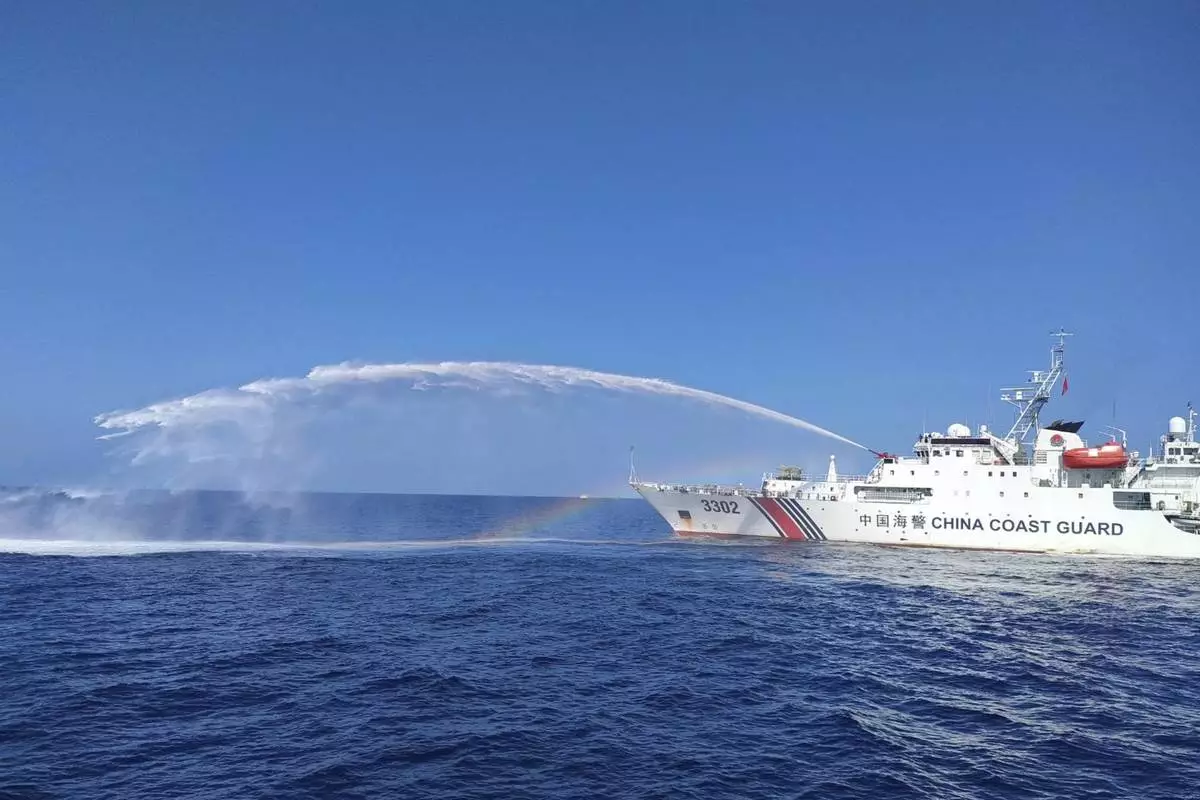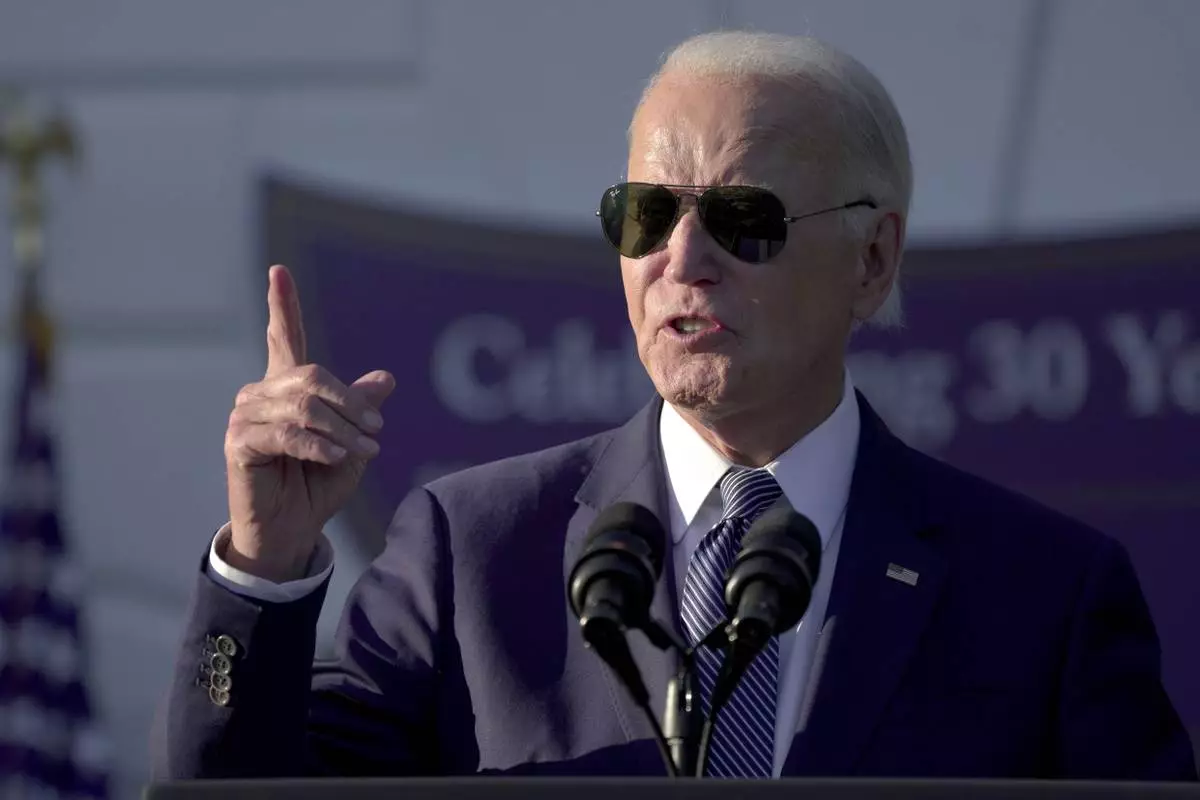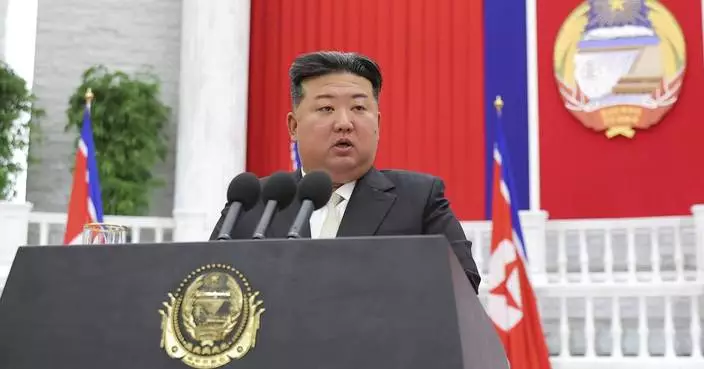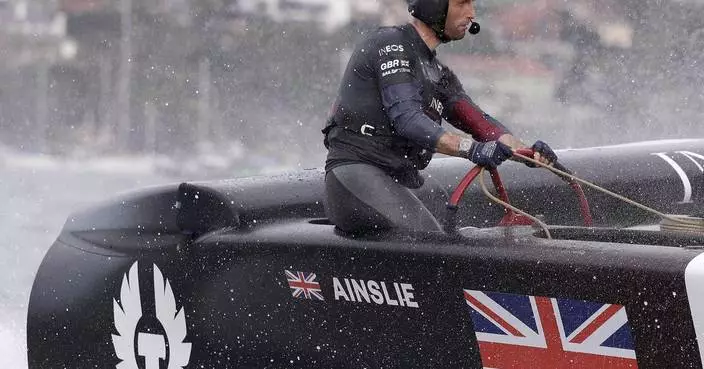BEIJING (AP) — Chinese coast guard ships fired water cannons and blocked and rammed a Philippine fisheries vessel Sunday in the disputed South China Sea, where hostilities between the Asian neighbors have flared alarmingly at sea and spread into the air in recent weeks.
China and the Philippines blamed each other for the tense confrontations in the high seas off Sabina Shoal, which has become a new flashpoint, where both have deployed coast guard ships on suspicion that either one may take steps to seize the uninhabited atoll.
The Chinese coast guard said that it took action against a Philippine vessel, which entered waters in the vicinity of Sabina and ignored warnings, leading to a minor collision.
Chinese coast guard spokesperson Gan Yu said that the Philippine ship sailed toward the Chinese coast guard ship “unprofessionally” and “dangerously,” causing the two vessels to brush against each other. The Philippine vessel had journalists onboard to take pictures to “distort facts,” he said.
"The responsibility is totally on the Philippines’ side. We sternly warn that the Philippine side must immediately stop the infringement and provocation, otherwise it must bear all consequences,” Gan said without elaborating on the control measures that the Chinese side employed.
A Philippine government task force said that a vessel of the Bureau of Fisheries and Aquatic Resources, the BRP Datu Sanday, “encountered aggressive and dangerous maneuvers from eight People’s Republic of China maritime vessels" while cruising to Sabina, causing its engine to fail and hampering its effort to provide diesel, food and medical supplies to Filipino fishermen.
The Chinese coast guard ships, which were backed by a navy ship, “made close perilous maneuvers that resulted in ramming, blasted horns and deployed water cannons against the BFAR vessel,” endangering its crew, according to the Philippine task force, which oversees the territorial disputes.
"The Philippine government calls on the People’s Republic of China to halt these provocative actions that destabilize regional peace and security,” the task force said, adding that the Philippines would continue to assert its rights.
The United States expressed its support for the Philippines, its oldest treaty ally in Asia. U.S. Ambassador MaryKay Carlson said in a statement posted on X that China's actions were “unsafe, unlawful and aggressive” and “disrupted a legal Philippine mission, endangering lives — the latest in multiple dangerous actions.”
China is rapidly expanding its military and has become increasingly assertive in pursuing its territorial claims in the South China Sea, which Beijing claims virtually in its entirety. The tensions have led to more frequent confrontations, primarily with the Philippines, though the longtime territorial disputes also involve other claimants, including Vietnam, Taiwan, Malaysia and Brunei.
The latest incident came days after Chinese and Philippine coast guard ships collided near the disputed Sabina Shoal, which Beijing calls Xianbin and Manila refers to as Escoda. Two Philippine vessels were damaged in Monday’s collision, but there were no reports of injuries.
Sabina Shoal lies about 140 kilometers (85 miles) west of the Philippine province of Palawan, in the internationally recognized exclusive economic zone of the Philippines.
Sabina is near the Second Thomas Shoal, another flashpoint where China has hampered the resupply of Philippine forces aboard a long-grounded navy ship. Last month, China and the Philippines reached an agreement to prevent increasingly hostile confrontations at the Second Thomas Shoal.

FILE - In this photo provided by the Philippine Coast Guard, a Chinese Coast Guard ship, right, uses its water cannons on a Philippine Bureau of Fisheries and Aquatic Resources (BFAR) vessel, as it approaches Scarborough Shoal in the disputed South China Sea, on Dec. 9, 2023. (Philippine Coast Guard via AP, File)
WASHINGTON (AP) — United States President Joe Biden and British Prime Minister Keir Starmer are meeting Friday amid an intensified push by Ukraine to loosen restrictions on using weapons provided by the U.S. and Britain to strike Russia.
The talks come amid signs that the White House could be moving toward a shift in its policy, and as Russia’s President Vladimir Putin warned that Ukraine’s use of long-range weapons would put NATO at war with Moscow.
Ukrainian officials renewed their pleas to use Western-provided long-range missiles against targets deeper inside Russia during this week’s visit to Kyiv by U.S. Secretary of State Antony Blinken and U.K. Foreign Secretary David Lammy. Blinken said he had “no doubt” that Biden and Starmer would discuss the matter during their visit, noting the U.S. has adapted and “will adjust as necessary” as Russia’s battlefield strategy has changed.
The language is similar to what Blinken said in May, shortly before the U.S. allowed Ukraine to use American-provided weapons just inside Russian territory. The distance has been largely limited to cross-border targets deemed a direct threat out of concerns about further escalating the conflict.
While the issue is expected to be at the top of the leaders’ agenda, it appeared unlikely that Biden and Starmer would announce any policy changes during this week’s visit, according to two U.S. officials familiar with planning for the leaders' talks who spoke on condition of anonymity because they weren't authorized to discuss the private deliberations.
In addition to Blinken, Biden also has hinted a change could be afoot. In an exchange with reporters earlier this week about whether he was ready to ease weapons restrictions on Ukraine, he responded, “We’re working that out now.”
Putin warned Thursday that allowing long-range strikes “would mean that NATO countries, the United States, and European countries are at war with Russia. … If this is so, then, bearing in mind the change in the very essence of this conflict, we will make appropriate decisions based on the threats that will be created for us.”
His remarks were in line with the narrative the Kremlin has actively promoted since early in the Ukraine war, accusing NATO countries of de-facto participation in the conflict and threatening a response.
Earlier in the year, Putin warned that Russia could provide long-range weapons to others to strike Western targets in response to NATO allies allowing Ukraine to use their arms to attack Russian territory, saying it “would mark their direct involvement in the war against the Russian Federation, and we reserve the right to act the same way.”
Starmer, in response to the Russian leader's Thursday comments, said on his way to the U.S. that Britain does not seek any conflict with Russia.
“Russia started this conflict. Russia illegally invaded Ukraine. Russia could end this conflict straight away,” Starmer told reporters. “Ukraine has the right to self-defense and we’ve obviously been absolutely fully supportive of Ukraine’s right to self-defense — we’re providing training capability, as you know."
“But we don’t seek any conflict with Russia — that’s not our intention in the slightest,” Starmer said.
Ukrainian President Volodymyr Zelenskyy has pressed U.S. and allied military leaders to go much further. He argues that the U.S. must allow Ukraine to target Russian air bases and launch sites far from the border as Russia has stepped up assaults on Ukraine’s electricity grid and utilities ahead of the coming winter.
Zelenskyy also wants more long-range weaponry from the United States, including the Army Tactical Missile System, known as ATACMS, for strikes in Russia.
ATACMS wouldn’t be the answer to the main threat Ukraine faces from long-range Russian glide bombs, which are being fired from more than 300 kilometers (185 miles) away, beyond the ATACMS' reach, said Lt. Col. Charlie Dietz, Pentagon spokesperson.
American officials also don’t believe they have enough of the weapon systems available to provide Ukraine with the number to make a substantive difference to conditions on the ground, one of the U.S. officials said.
During a meeting of allied defense ministers last week, Defense Secretary Lloyd Austin said he did not believe providing Ukraine with long-range weapon systems would be a game-changer in the grueling war. He noted that Ukraine has already been able to strike inside Russia with its own internally produced systems, including drones.
“I don’t believe one capability is going to be decisive, and I stand by that comment,” Austin said.
“As of right now, the policy has not changed," Maj. Gen. Pat Ryder, Pentagon press secretary, said Thursday.
Starmer said he was visiting Washington for “strategic meetings to discuss Ukraine and to discuss the Middle East.” It’s the prime minister’s second meeting with Biden since his center-left government was elected in July.
It comes after Britain last week diverged from the U.S. by suspending some arms exports to Israel because of the risk they could be used to break international law. Both countries have downplayed their differences over the issue.
Biden and Starmer’s meeting also comes ahead of this month’s annual meeting of global leaders at the United Nations General Assembly. The Oval Office meeting was scheduled in part to help the two leaders compare notes on the war in Ukraine, languishing efforts to get a cease-fire deal in Gaza and other issues ahead of the U.N. meeting.
The White House also has sought in recent days to put a greater emphasis on the nexus between the war in Ukraine and conflict in the Middle East sparked after Iranian-backed Hamas militants in Gaza launched attacks on Israel on Oct. 7.
The Biden administration said this week that Iran recently delivered short-range ballistic weapons to Russia to use against Ukraine, a transfer that White House officials worry will allow Russia to use more of its arsenal for targets far beyond the Ukrainian front line while employing Iranian warheads for closer-range targets.
In turn, the U.S. administration says Russia has been tightening its relationship with Iran, including by providing it with nuclear and space technology.
“This is obviously deeply concerning,” White House national security spokesperson John Kirby said of the missile transfer. “And it certainly speaks to the manner in which this partnership threatens European security and how it illustrates Iran’s destabilizing influence now reaches well beyond the Middle East.”
AP reporters Tara Copp in Washington, Jill Lawless in London, Matthew Lee in Warsaw, Poland, and Dasha Litvinova in Tallinn, Estonia, contributed.

President Joe Biden speaks during the Violence Against Women Act 30th anniversary celebration on the South Lawn of the White House, Thursday, Sept. 12, 2024, in Washington. (AP Photo/Manuel Balce Ceneta)

Britain's Prime Minister Keir Starmer, center, talks to the media on board his plane as he flies to Washington DC., Thursday Sept. 12, 2024. (Stefan Rousseau/Pool via AP)












